Identification of Dominant Controlling Factors and Susceptibility Assessment of Coseismic Landslides Triggered by the 2022 Luding Earthquake
Abstract
1. Introduction
2. Study Area
3. Materials and Methodology
3.1. Sources of Data
3.2. Selection of Coseismic Landslide Influencing Factors
3.2.1. Topographic Factors
3.2.2. Geological and Seismic Factors
3.2.3. Hydrological and Anthropogenic Factor
3.3. Coseismic Landslide Susceptibility Assessment Methods
3.3.1. Frequency Ratio Method
3.3.2. Analytical Hierarchy Process
- (1)
- Establish a hierarchical structure model, clarifying the relationships between influencing factors. By defining recursive interactions among influencing factors at the criterion and sub-criterion levels, the hierarchical structure model is developed;
- (2)
- Build the judgment matrix, which serves as the foundation of the AHP approach. This process entails conducting pairwise comparisons to evaluate the relative significance of factors within the sub-criterion layer corresponding to each criterion, resulting in a judgment matrix. In traditional AHP, the relative importance of two factors is qualitatively expressed as equally important, slightly important, moderately important, strongly important, and extremely important, and is quantified using a scale of 1, 3, 5, 7, and 9. In the context of coseismic landslide susceptibility and multi-criteria analysis, the feasibility of replacing expert judgment with data-driven indicators has already been demonstrated [51]. In this paper, the judgment matrix is constructed by pairwise comparison of the values between the influencing factors;
- (3)
- To confirm the reliability of the weights calculated from the judgment matrix, a consistency evaluation is conducted based on Equations (4) and (5);
- (4)
- Calculate the overall weight of each influencing factor. After passing the consistency test, normalize the weight of each influencing factor at all levels to compute the comprehensive weight value (), and create a ranking table of the comprehensive weights of the influencing factors.
3.3.3. Pearson Correlation Coefficient
3.4. Methodology Flow
4. Results and Analysis
4.1. Spatial Pattern of Coseismic Landslides Across Influencing Factors
4.2. Determination of Initial Weights for Influence Factors
4.3. Correlation Analysis of Influence Factors and Normalization of Filtrated Weights
4.4. Mapping of Coseismic Landslide Susceptibility Zoning
4.5. Validation of Coseismic Landslide Susceptibility Zoning Results
5. Discussion
5.1. Controlling Factors of the Coseismic Landslides
5.2. Influence of the Seismogenic Fault
5.3. Limitations and Research Prospects
6. Conclusions
- (1)
- An updated landslide inventory for the Luding earthquake was created, documenting 13,717 landslides within the study area, covering a total area of 39.27 km2.
- (2)
- The study area was divided into five susceptibility categories, with very-high- and high-susceptibility zones mainly located along the Dadu river and the Moxi segment of the Xianshuihe fault. Particularly, towns such as Tianwan, Caoke, Detuo, and Moxi fall within the very high susceptibility zone, warranting focused landslide hazard investigations.
- (3)
- The elevation variation coefficient, slope aspect, and slope gradient are the main controlling factors of coseismic landslide distribution. Coseismic landslide susceptibility is highest when the elevation variation coefficient is between 0.1 and 0.134, the slope aspect is southeast, and the slope gradient ranges from 70° to 76.63°.
- (4)
- The coseismic landslide susceptibility model established using the FR-AHP-Pearson model achieved a prediction accuracy of 0.8445, indicating high accuracy, and can be widely applied in coseismic landslide susceptibility assessment.
Author Contributions
Funding
Data Availability Statement
Acknowledgments
Conflicts of Interest
References
- Xu, C.; Xu, X.W. Response rate of seismic slope mass movements related to 2008 Wenchuan earthquake and its spatial distribution analysis. Chin. J. Rock Mech. Eng. 2013, 32, 3888–3908. [Google Scholar]
- Keefer, D.K. Landslides caused by earthquakes. Geol. Soc. Am. Bull. 1984, 95, 406–421. [Google Scholar] [CrossRef]
- Wang, F.; Fan, X.; Yunus, A.P.; Siva Subramanian, S.; Alonso-Rodriguez, A.; Dai, L.; Xu, Q.; Huang, R. Coseismic Landslides Triggered by the 2018 Hokkaido, Japan (Mw 6.6), Earthquake: Spatial Distribution, Controlling Factors, and Possible Failure Mechanism. Landslides 2019, 16, 1551–1566. [Google Scholar] [CrossRef]
- Alexander, D. Preliminary Assessment of Landslides Resulting from the Earthquake of 23rd November 1980 in Southern Italy. Disasters 1981, 5, 376–383. [Google Scholar] [CrossRef]
- Keefer, D.K. Statistical Analysis of an Earthquake-Induced Landslide Distribution—The 1989 Loma Prieta, California Event. Eng. Geol. 2000, 58, 231–249. [Google Scholar] [CrossRef]
- Deng, Q.D.; Zhang, P.Z.; Ran, Y.K.; Yang, X.P.; Min, W.; Chen, L.C. Active tectonics and earthquake activities in China. Geosci. Front. 2003, 10, 66–73. [Google Scholar]
- Xu, C.; Xu, X.W.; Dai, F.C.; Wu, Z.D.; He, H.L.; Shi, F.; Wu, X.Y.; Xu, S.N. Application of an incomplete landslide inventory, logistic regression model and its validation for landslide susceptibility mapping related to the 12 May 2008 Wenchuan earthquake of China. Nat. Hazards 2013, 68, 883–900. [Google Scholar] [CrossRef]
- Xu, C.; Xu, X.W.; Wu, X.Y.; Dai, F.C.; Yao, X.; Yao, Q. Detailed catalog of landslides triggered by the 2008 Wenchuan earthquake and statistical analyses of their spatial distribution. J. Eng. Geol. 2013, 21, 25–44. [Google Scholar]
- Fan, X.M.; Wang, X.; Dai, L.X.; Fang, C.Y.; Deng, Y.; Zou, C.B.; Tang, M.G.; Wei, Z.L.; Dou, X.Y.; Zhang, J.; et al. Characteristics and spatial distribution pattern of M S 6.8 Luding earthquake occurred on 5 September 2022. J. Eng. Geol. 2022, 30, 1504–1516. [Google Scholar]
- Xiao, Z.; Xu, C.; Huang, Y.; He, X.; Shao, X.; Chen, Z.; Xie, C.; Li, T.; Xu, X. Analysis of Spatial Distribution of Landslides Triggered by the Ms 6.8 Luding Earthquake in China on 5 September 2022. Geoenviron. Disasters 2023, 10, 3. [Google Scholar] [CrossRef]
- Ma, S.; Lu, Y.; Xia, C.; Liu, X.; Qi, W.; Yuan, R. Brief Report of Landslides Triggered by the 2022 Ms 6.8 Luding Earthquake, Sichuan, China. Landslides 2023, 20, 2695–2707. [Google Scholar] [CrossRef]
- Ma, S.; Shao, X.; Xu, C.; Chen, X.; Lu, Y.; Xia, C.; Qi, W.; Yuan, R. Distribution Pattern, Geometric Characteristics and Tectonic Significance of Landslides Triggered by the Strike-Slip Faulting 2022 Ms 6.8 Luding Earthquake. Geomorphology 2024, 453, 109138. [Google Scholar] [CrossRef]
- Shao, X.; Ma, S.; Xu, C.; Xie, C.; Li, T.; Huang, Y.; Huang, Y.; Xiao, Z. Landslides Triggered by the 2022 Ms. 6.8 Luding Strike-Slip Earthquake: An Update. Eng. Geol. 2024, 335, 107536. [Google Scholar] [CrossRef]
- Sun, Y.K. Stability analysis of slopes in rock. Chin. J. Rock. Mech. Eng. 1986, 5, 91G102. [Google Scholar]
- Terzaghi, K.; Peck, R.B.; Mesri, G. Soil Mechanics in Engineering Practice; John Wiley & Sons: Hoboken, NJ, USA, 1996; ISBN 978-0-471-08658-1. [Google Scholar]
- Newmark, N.M. Effects of Earthquakes on Dams and Embankments. Géotechnique 1965, 15, 139–160. [Google Scholar] [CrossRef]
- Zang, M.; Qi, S.; Zou, Y.; Sheng, Z.; Zamora, B.S. An Improved Method of Newmark Analysis for Mapping Hazards of Coseismic Landslides. Nat. Hazards Earth Syst. Sci. 2020, 20, 713–726. [Google Scholar] [CrossRef]
- Yang, G.; Qi, S.; Wu, F.; Zhan, Z. Seismic Amplification of the Anti-Dip Rock Slope and Deformation Characteristics: A Large-Scale Shaking Table Test. Soil. Dyn. Earthq. Eng. 2018, 115, 907–916. [Google Scholar] [CrossRef]
- Zang, M.D.; Yang, G.X.; Dong, J.Y.; Qi, S.W.; He, J.X.; Liang, N. Experimental Study on Seismic Response and Progressive Failure Characteristics of Bedding Rock Slopes. J. Rock. Mech. Geotech. 2022, 14, 1394–1405. [Google Scholar] [CrossRef]
- Lee, S.; Talib, J.A. Probabilistic Landslide Susceptibility and Factor Effect Analysis. Environ. Geol. 2005, 47, 982–990. [Google Scholar] [CrossRef]
- Wang, L.; Chang, M.; Xing, Y.L. Risk assessment of landslide geological hazards based on information method model and GIS. Hazards Environ. Prot. 2021, 32, 14–20. [Google Scholar]
- Chen, J.; Li, J.; Qin, X.; Dong, Q.; Sun, Y. RS and GIS-Based Statistical Analysis of Secondary Geological Disasters after the 2008 Wenchuan Earthquake. Acta Geol. Sin.–Engl. Ed. 2009, 83, 776–785. [Google Scholar] [CrossRef]
- Zhang, Y.B.; Xu, P.F.; Lin, J.F.; Wu, X.N.; Liu, J.; Xiang, C.L.; He, Y.Y.; Yang, C.F.; Xu, C. Earthquake-triggered landslide susceptibility prediction in Jiuzhaigou based on BP neural network. J. Eng. Geol. 2024, 32, 133–145. [Google Scholar]
- Xu, C.; Dai, F.; Xu, X.; Lee, Y.H. GIS-Based Support Vector Machine Modeling of Earthquake-Triggered Landslide Susceptibility in the Jianjiang River Watershed, China. Geomorphology 2012, 145–146, 70–80. [Google Scholar] [CrossRef]
- Tie, Y.B.; Zhang, X.Z.; Lu, J.Y.; Liang, J.T.; Wang, D.H.; Ma, Z.G.; Li, Z.L.; Lu, T.; Shi, S.W.; Liu, M.S.; et al. Characteristics of geological hazards and it’s mitigations of the Ms6. 8 earthquake in Luding County, Sichuan Province. Hydrogeol. Eng. Geol. 2022, 49, 1–12. [Google Scholar]
- Wang, X.; Fang, C.; Tang, X.; Dai, L.; Fan, X.; Xu, Q. Research on emergency evaluation of landslides induced by the Luding Ms 6.8 earthquake. Geomat. Inf. Sci. Wuhan University 2023, 48, 25–35. [Google Scholar]
- Bai, M.; Chevalier, M.L.; Leloup, P.H.; Li, H.; Pan, J.; Replumaz, A.; Wang, S.; Li, K.; Wu, Q.; Liu, F.; et al. Spatial Slip Rate Distribution Along the SE Xianshuihe fault, Eastern Tibet, and Earthquake Hazard Assessment. Tectonics 2021, 40, e2021TC006985. [Google Scholar] [CrossRef]
- Bai, M.; Chevalier, M.L.; Pan, J.; Replumaz, A.; Leloup, P.H.; Métois, M.; Li, H. Southeastward Increase of the Late Quaternary Slip-Rate of the Xianshuihe fault, Eastern Tibet. Geodynamic and Seismic Hazard Implications. Earth Planet. Sci. Lett. 2018, 485, 19–31. [Google Scholar] [CrossRef]
- Huang, Y.; Xie, C.; Li, T.; Xu, C.; He, X.; Shao, X.; Xu, X.; Zhan, T.; Chen, Z. An Open-Accessed Inventory of Landslides Triggered by the MS 6.8 Luding Earthquake, China on 5 September 2022. Earthq. Res. Adv. 2023, 3, 100181. [Google Scholar] [CrossRef]
- Gokceoglu, M.E. Candan Assessment of Landslide Susceptibility for a Landslide-Prone Area (North of Yenice, NW Turkey) by Fuzzy Approach. Environ. Geol. 2002, 41, 720–730. [Google Scholar] [CrossRef]
- He, J.; Qi, S.; Zhan, Z.; Guo, S.; Li, C.; Zheng, B.; Huang, X.; Zou, Y.; Yang, G.; Liang, N. Seismic Response Characteristics and Deformation Evolution of the Bedding Rock Slope Using a Large-Scale Shaking Table. Landslides 2021, 18, 2835–2853. [Google Scholar] [CrossRef]
- Sun, D.; Chen, D.; Zhang, J.; Mi, C.; Gu, Q.; Wen, H. Landslide susceptibility mapping based on interpretable machine learning from the perspective of geomorphological differentiation. Land 2023, 12, 1018. [Google Scholar] [CrossRef]
- Ma, S.; Chen, J.; Wu, S.; Li, Y. Landslide Susceptibility Prediction Using Machine Learning Methods: A Case Study of Landslides in the Yinghu Lake Basin in Shaanxi. Sustainability 2023, 15, 15836. [Google Scholar] [CrossRef]
- Huang, F.; Yang, J.; Zhang, B.; Li, Y.; Huang, J.; Chen, N. Regional Terrain Complexity Assessment Based on Principal Component Analysis and Geographic Information System: A Case of Jiangxi Province, China. ISPRS Int. J. Geoinf. 2020, 9, 539. [Google Scholar] [CrossRef]
- Huang, F.; Yao, C.; Liu, W.; Li, Y.; Liu, X. Landslide Susceptibility Assessment in the Nantian Area of China: A Comparison of Frequency Ratio Model and Support Vector Machine. Geomat. Nat. Hazards Risk 2018, 9, 919–938. [Google Scholar] [CrossRef]
- Kumar, A.; Sharma, R.K.; Bansal, V.K. GIS-Based Comparative Study of Information Value and Frequency Ratio Method for Landslide Hazard Zonation in a Part of Mid-Himalaya in Himachal Pradesh. Innov. Infrastruct. Solut. 2019, 4, 28. [Google Scholar] [CrossRef]
- Pradhan, B.; Lee, S. Delineation of Landslide Hazard Areas on Penang Island, Malaysia, by Using Frequency Ratio, Logistic Regression, and Artificial Neural Network Models. Environ. Earth Sci. 2010, 60, 1037–1054. [Google Scholar] [CrossRef]
- Xu, C.; Dai, F.C.; Yao, X.; Chen, J.; Tu, X.B.; Sun, Y.; Wang, Z.Y. GIS-based landslide susceptibility assessment using analytical hierarchy process in Wenchuan earthquake region. Chin. J. Rock. Mech. Eng. 2009, 28, 3978–3985. [Google Scholar]
- Saaty, R.W. The Analytic Hierarchy Process—What It Is and How It Is Used. Math. Model. 1987, 9, 161–176. [Google Scholar] [CrossRef]
- Zou, F.B.; Fu, Z.; Fan, L.F.; Wu, H.; Guo, Z. Evaluation of landslide susceptibility in eastern Tibet based on frequency ratio and AHP model. J. Nat. Disasters 2023, 32, 235–242. [Google Scholar]
- Saaty, T.L. A Scaling Method for Priorities in Hierarchical Structures. J. Math. Psychol. 1977, 15, 234–281. [Google Scholar] [CrossRef]
- Cheng, S.P.; Wang, R.Y. Analyzing hazard potential of typhoon damage by applying grey analytic hierarchy process. Nat. Hazards 2004, 33, 77–103. [Google Scholar] [CrossRef]
- Zhang, G.; Cai, Y.; Zheng, Z.; Zhen, J.; Liu, Y.; Huang, K. Integration of the Statistical Index Method and the Analytic Hierarchy Process Technique for the Assessment of Landslide Susceptibility in Huizhou, China. Catena 2016, 142, 233–244. [Google Scholar] [CrossRef]
- Gorsevski, P.V.; Jankowski, P.; Gessler, P.E. An heuristic approach for mapping landslide hazard by integrating fuzzy logic with analytic hierarchy process. Control. Cybern. 2006, 35, 121–146. [Google Scholar]
- Lang, L.; Fu-bao, Z. A Comprehensive Hazard Evaluation System for Spontaneous Combustion of Coal in Underground Mining. Int. J. Coal. Geol. 2010, 82, 27–36. [Google Scholar] [CrossRef]
- Nefeslioglu, H.A.; Sezer, E.A.; Gokceoglu, C.; Ayas, Z. A Modified Analytical Hierarchy Process (M-AHP) Approach for Decision Support Systems in Natural Hazard Assessments. Comput. Geosci. 2013, 59, 1–8. [Google Scholar] [CrossRef]
- Sarmah, T.; Das, S.; Narendr, A.; Aithal, B.H. Assessing Human Vulnerability to Urban Flood Hazard Using the Analytic Hierarchy Process and Geographic Information System. Int. J. Disaster Risk Reduct. 2020, 50, 101659. [Google Scholar] [CrossRef]
- Luu, C.; Von Meding, J.; Kanjanabootra, S. Assessing Flood Hazard Using Flood Marks and Analytic Hierarchy Process Approach: A Case Study for the 2013 Flood Event in Quang Nam, Vietnam. Nat. Hazards 2018, 90, 1031–1050. [Google Scholar] [CrossRef]
- Stefanidis, S.; Stathis, D. Assessment of Flood Hazard Based on Natural and Anthropogenic Factors Using Analytic Hierarchy Process (AHP). Nat. Hazards 2013, 68, 569–585. [Google Scholar] [CrossRef]
- Kohno, M.; Higuchi, Y.; Ono, Y. Evaluating Earthquake-Induced Widespread Slope Failure Hazards Using an AHP-GIS Combination. Nat. Hazards 2022, 116, 1485–1512. [Google Scholar] [CrossRef]
- Myronidis, D.; Papageorgiou, C.; Theophanous, S. Landslide Susceptibility Mapping Based on Landslide History and Analytic Hierarchy Process (AHP). Nat. Hazards 2016, 81, 245–263. [Google Scholar] [CrossRef]
- Rogers, G.S. A Course in Theoretical Statistics. Technometrics 1969, 11, 840–841. [Google Scholar] [CrossRef]
- Woodard, J.B.; Mirus, B.B.; Crawford, M.M.; Or, D.; Leshchinsky, B.A.; Allstadt, K.E.; Wood, N.J. Mapping Landslide Susceptibility Over Large Regions With Limited Data. J. Geophys. Res. Earth Surf. 2023, 128, e2022JF006810. [Google Scholar] [CrossRef]
- Xu, C.; Xu, X.; Yao, X.; Dai, F. Three (Nearly) Complete Inventories of Landslides Triggered by the 12 May 2008 Wenchuan Mw 7.9 Earthquake of China and Their Spatial Distribution Statistical Analysis. Landslides 2014, 11, 441–461. [Google Scholar] [CrossRef]
- Atkinson, P.M.; Massari, R. Autologistic Modelling of Susceptibility to Landsliding in the Central Apennines, Italy. Geomorphology 2011, 130, 55–64. [Google Scholar] [CrossRef]
- Huang, F.M.; Yin, K.L.; Jiang, S.H.; Huang, J.S.; Cao, Z.S. Landslide susceptibility assessment based on clustering analysis and support vector machine. Chin. J. Rock. Mech. Eng. 2018, 37, 156–167. [Google Scholar]
- Guo, Z.Z.; Yin, K.L.; Huang, F.M.; Fu, S.; Zhang, W. Evaluation of landslide susceptibility based on landslide classification and weighted frequency ratio model. Chin. J. Rock. Mech. Eng. 2019, 38, 287–300. [Google Scholar]
- Wang, Y.; Yuan, R.M. Evaluation of landslide susceptibility in Qiaojia section of the Jinsha River Based on frequency ratio and AHP model. J. Hebei GEO Univ. 2023, 46, 131–140. [Google Scholar]
- Sedgwick, P. Pearson’s Correlation Coefficient. BMJ 2012, 345, e4483. [Google Scholar] [CrossRef]
- Gao, H.X.; Yin, K.L. Discuss on the correlations between landslides and rainfall and threshold for landslide early-warning and prediction. Rock Soil Mech. 2007, 28, 1055–1060. [Google Scholar]
- Cantarino, I.; Carrion, M.A.; Goerlich, F.; Martinez Ibañez, V. A ROC Analysis-Based Classification Method for Landslide Susceptibility Maps. Landslides 2019, 16, 265–282. [Google Scholar] [CrossRef]
- Lee, S.; Pradhan, B. Landslide Hazard Mapping at Selangor, Malaysia using frequency ratio and logistic regression models. Landslides 2007, 4, 33–41. [Google Scholar] [CrossRef]
- Ou, Y.X. Study on Regional Terrain Factors of Soil Erosion. Master’s Thesis, Northwest University, Kirkland, WA, USA, 2011. [Google Scholar]
- Yang, X.P.; Wang, P.; Li, X.F.; Xie, C.; Zhou, B.G.; Huang, X.N. Application of topographic slope and elevation variation coefficient in identifying the motuo active fault zone. Seismol. Geol. 2019, 41, 419–435. [Google Scholar]
- Chen, X.L.; Hui, H.J.; Zhao, Y.H. Study on the fault mechanics influences on the landslides distribution: A case study from the Wenchuan earthquake. Seismol. Geol. 2014, 36, 358–367. [Google Scholar]
- Gorum, T.; Fan, X.; van Westen, C.J.; Huang, R.Q.; Xu, Q.; Tang, C.; Wang, G. Distribution Pattern of Coseismic landslides Triggered by the 12 May 2008 Wenchuan Earthquake. Geomorphology 2011, 133, 152–167. [Google Scholar] [CrossRef]
- Xu, C.; Xu, X.W. Logistic regression model and its validation for hazard mapping of landslides triggered by Yushu earthquake. J. Eng. Geol. 2012, 20, 326–333. [Google Scholar]
- Ma, S.Y.; Xu, C.; Tian, Y.Y.; Xu, X.W. Application of logistic regression model for hazard assessment of earthquake-triggered landslides: A case study of 2017 Jiuzhaigou (China) Ms7.0 event. Seismol. Geol. 2019, 41, 162–177. [Google Scholar]
- Massey, C.; Townsend, D.; Rathje, E.; Allstadt, K.E.; Lukovic, B.; Kaneko, Y.; Bradley, B.; Wartman, J.; Jibson, R.W.; Petley, D.N.; et al. Landslides Triggered by the 14 November 2016 Mw 7.8 Kaikōura Earthquake, New Zealand. Bull. Seismol. Soc. Am. 2018, 108, 1630–1648. [Google Scholar] [CrossRef]
- Chigira, M.; Yagi, H. Geological and Geomorphological Characteristics of Landslides Triggered by the 2004 Mid Niigta Prefecture Earthquake in Japan. Eng. Geol. 2006, 82, 202–221. [Google Scholar] [CrossRef]
- Xu, Q.; Li, W.L. Distribution of large-scale landslides induced by the Wenchuan earthquake. J. Eng. Geol. 2010, 18, 818–826. [Google Scholar]
- Xu, Q.; Zhang, S.; Li, W. Spatial Distribution of Large-Scale Landslides Induced by the 5.12 Wenchuan Earthquake. J. Mt. Sci. 2011, 8, 246–260. [Google Scholar] [CrossRef]
- Han, B.Q.; Liu, Z.J.; Chen, B.; Li, Z.H.; Yu, C.; Zhang, Y.; Peng, J.B. Coseismic deformation and slip distribution of the 2022 Luding M W 6.6 earthquake revealed by InSAR observations. Geomat. Inf. Sci. Wuhan Univ. 2023, 48, 36–46. [Google Scholar]
- Meng, Q.; Wang, Z.; Zhang, H. Seismicity Changes and Numerical Simulation of Coseismic Deformation Following the 2022 Ms6.8 Luding Earthquake in Sichuan, China. Sci. China Earth Sci. 2024, 67, 2507–2521. [Google Scholar] [CrossRef]
- Xu, J.; Ji, L.Y.; Liu, C.J. Regional deformation background and coseismic deformation characteristics of the 2022 Luding Ms 6.8 earthquake. Seismol. Geol. 2024, 46, 645–664. [Google Scholar]
- Liang, H.; Wu, Y.; Shao, Z.; Li, J.; Li, Y.; Yi, S.; Yang, F.; Zhuang, W.; Wang, H.; Zhan, W.; et al. Coseismic Slip and Deformation Mode of the 2022 Mw 6.5 Luding Earthquake Determined by GPS Observation. Tectonophysics 2023, 865, 230042. [Google Scholar] [CrossRef]
- Chang, K.T.; Merghadi, A.; Yunus, A.P.; Pham, B.T.; Dou, J. Evaluating Scale Effects of Topographic Variables in Landslide Susceptibility Models Using GIS-Based Machine Learning Techniques. Sci. Rep. 2019, 9, 12296. [Google Scholar] [CrossRef] [PubMed]
- Guzzetti, F.; Mondini, A.C.; Cardinali, M.; Fiorucci, F.; Santangelo, M.; Chang, K.T. Landslide Inventory Maps: New Tools for an Old Problem. Earth-Sci. Rev. 2012, 112, 42–66. [Google Scholar] [CrossRef]
- Korup, O.; Stolle, A. Landslide Prediction from Machine Learning. Geol. Today 2014, 30, 26–33. [Google Scholar] [CrossRef]
- Liu, L.N.; Xu, C.; Xu, X.W.; Chen, J. GIS-based landslide hazard evaluation using AHP method in the 2013 Lushan earthquake region. J. Catastrophol. 2014, 29, 183–191. [Google Scholar]
- Das, S.; Sarkar, S.; Kanungo, D.P. GIS-Based Landslide Susceptibility Zonation Mapping Using the Analytic Hierarchy Process (AHP) Method in Parts of Kalimpong Region of Darjeeling Himalaya. Environ. Monit. Assess. 2022, 194, 234. [Google Scholar] [CrossRef]
- Park, S.; Choi, C.; Kim, B.; Kim, J. Landslide Susceptibility Mapping Using Frequency Ratio, Analytic Hierarchy Process, Logistic Regression, and Artificial Neural Network Methods at the Inje Area, Korea. Environ. Earth Sci. 2013, 68, 1443–1464. [Google Scholar] [CrossRef]
- Roy, R.; Ghosh, D.; Bhattacharya, G. Influence of Strong Motion Characteristics on Permanent Displacement of Slopes. Landslides 2016, 13, 279–292. [Google Scholar] [CrossRef]

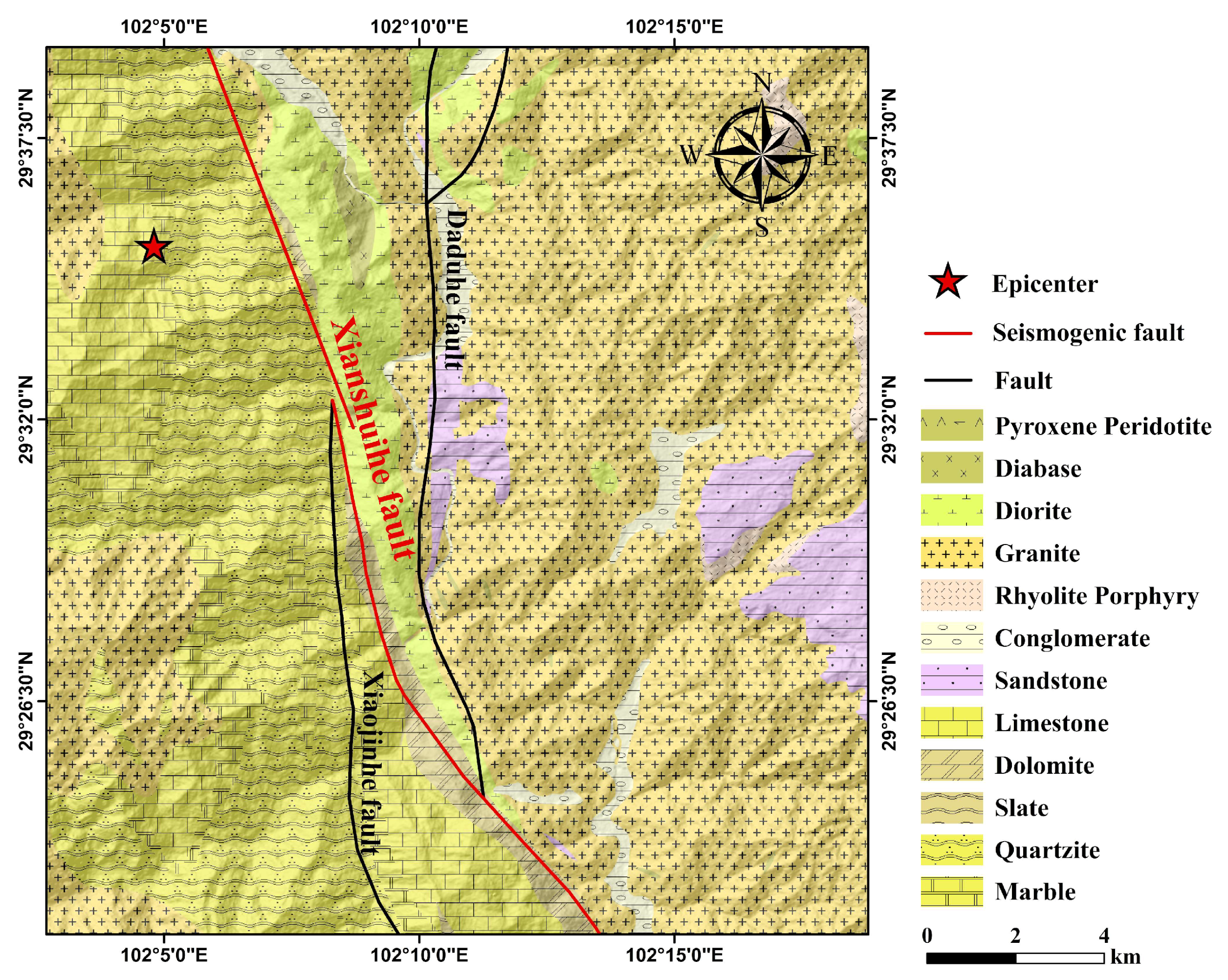
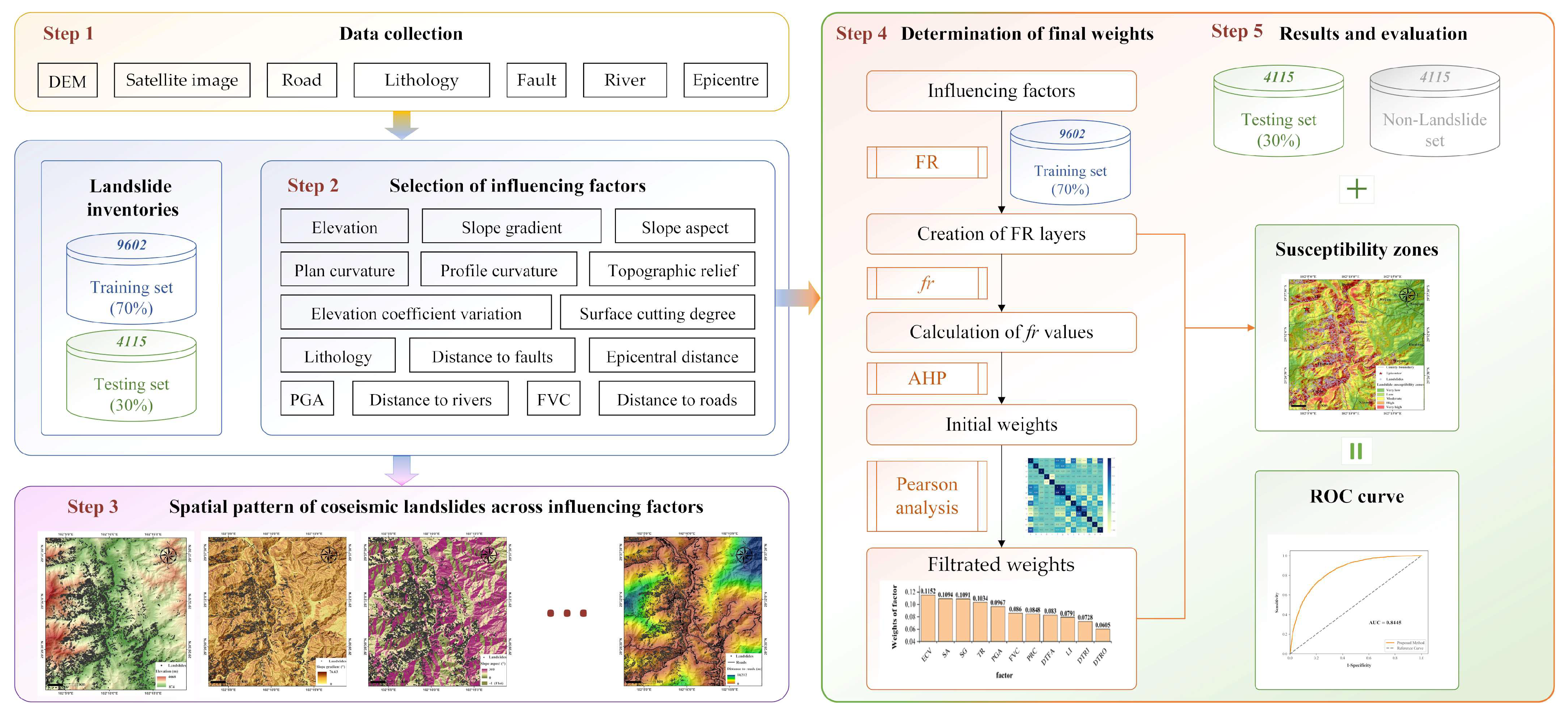

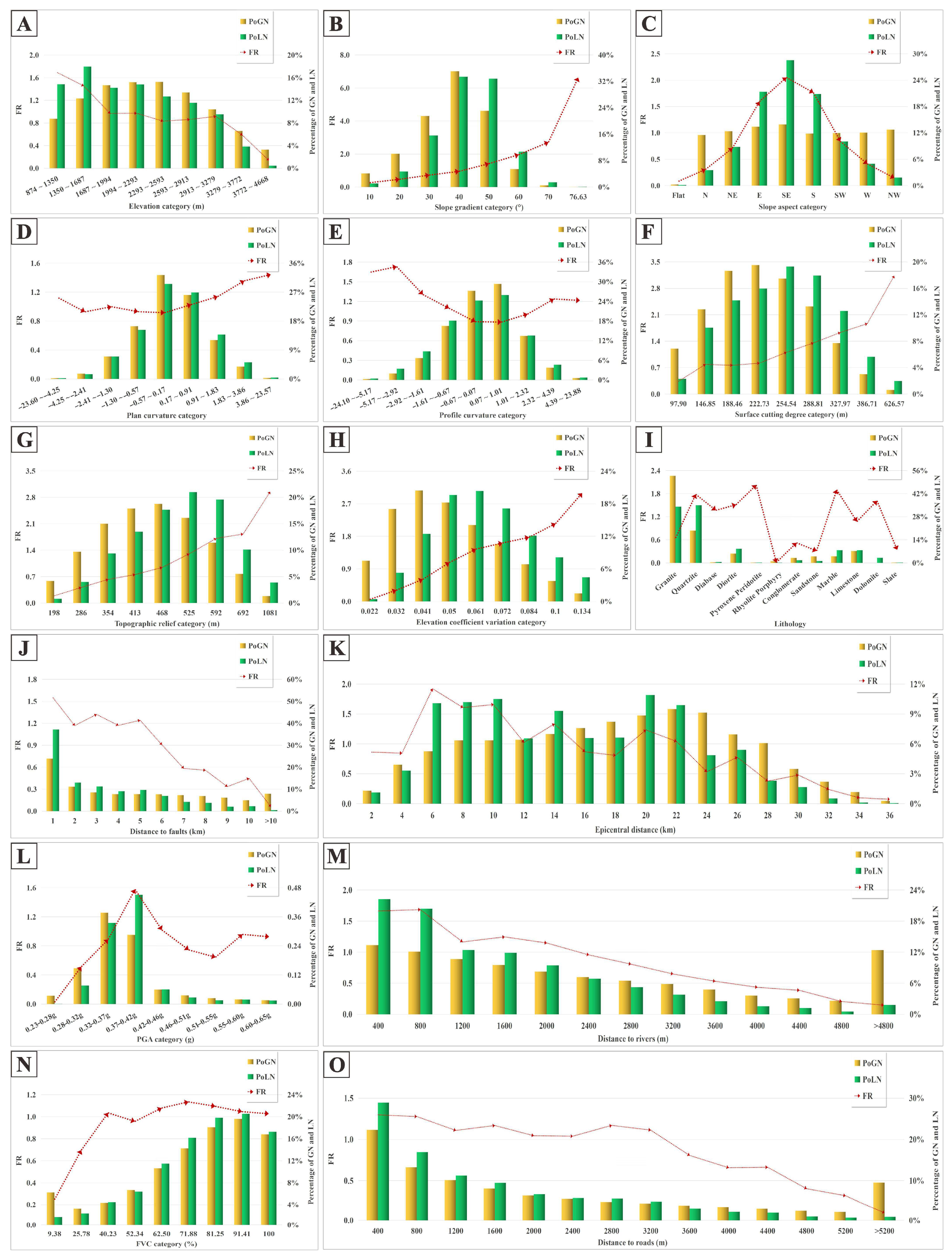
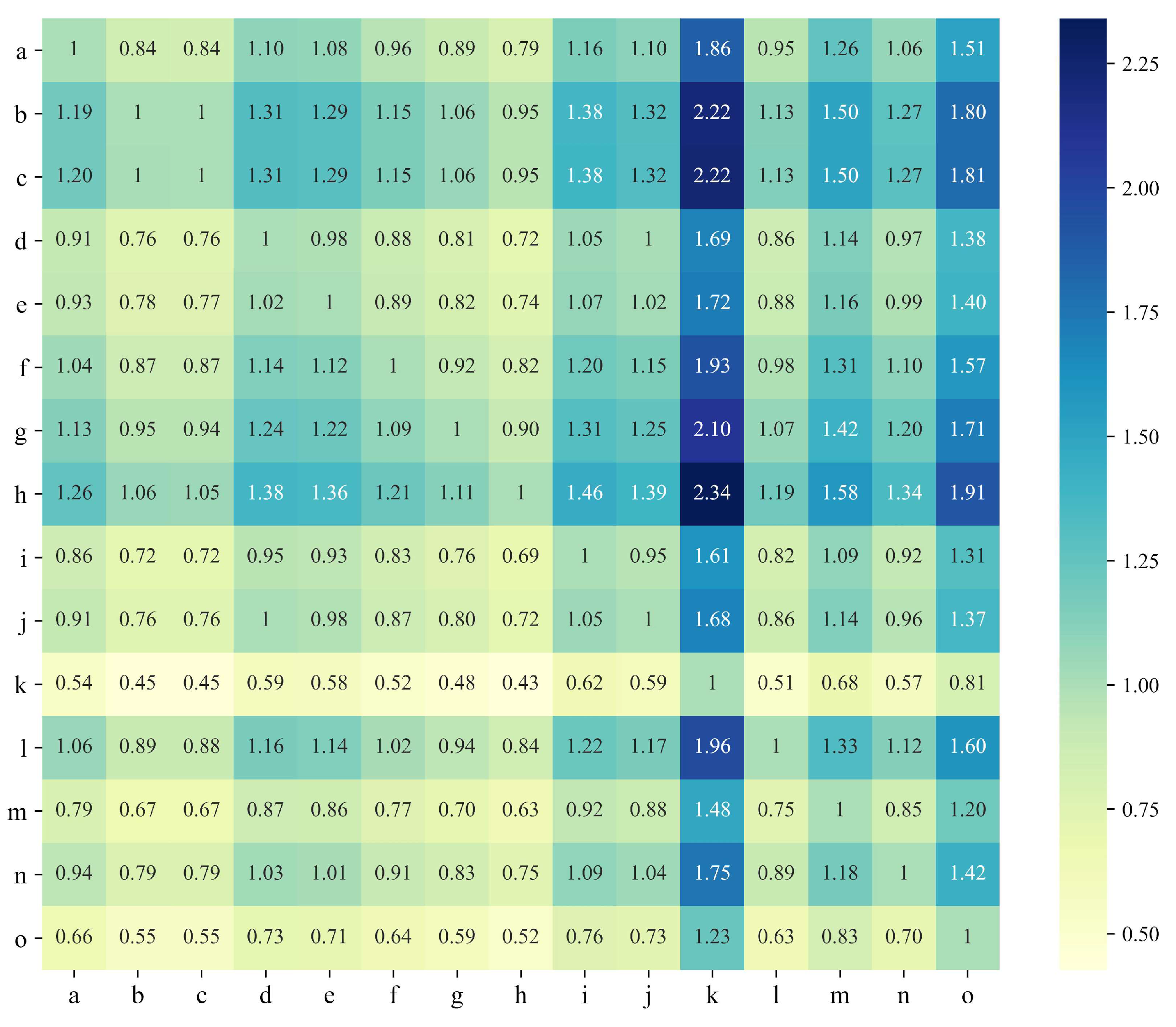

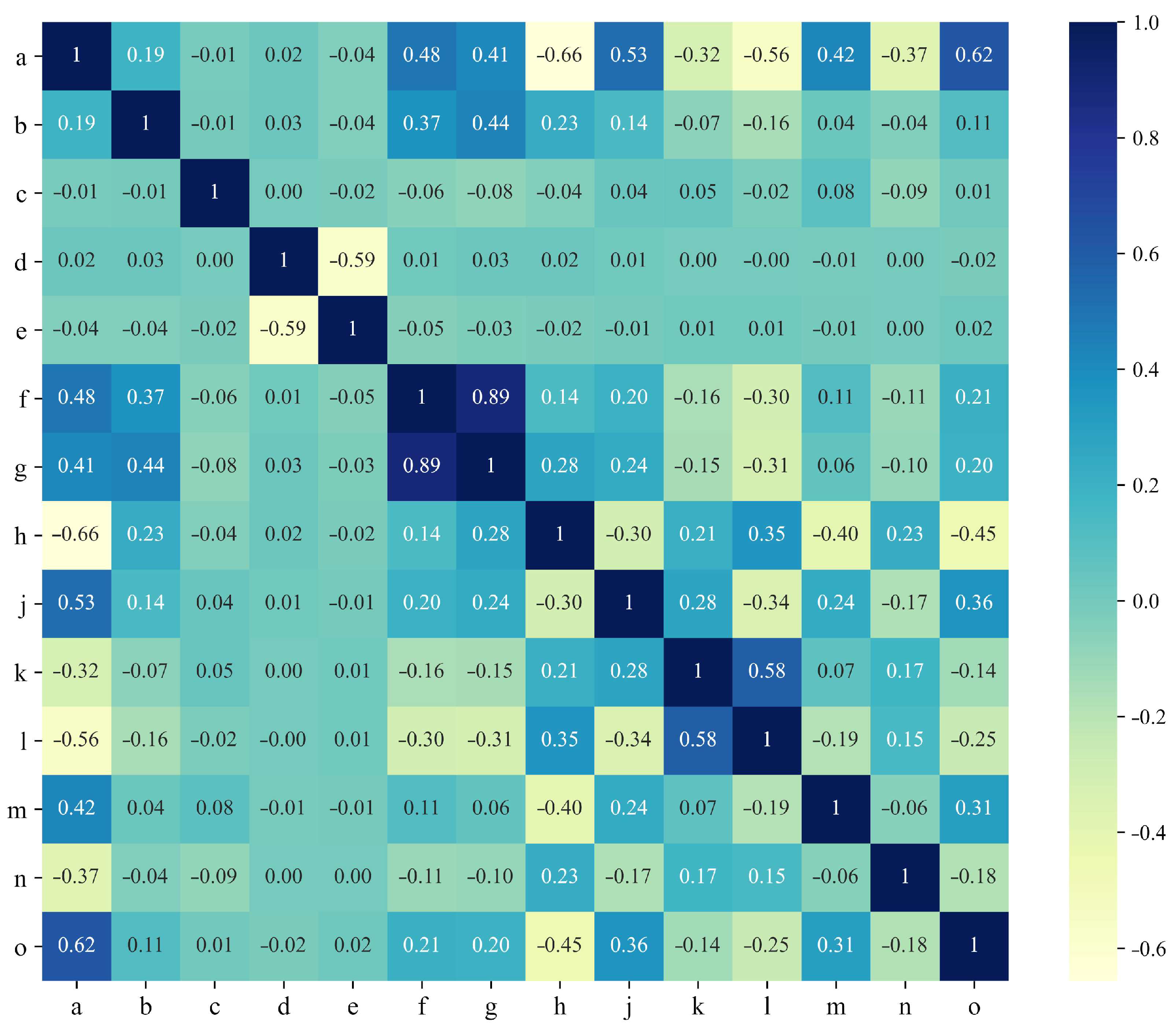

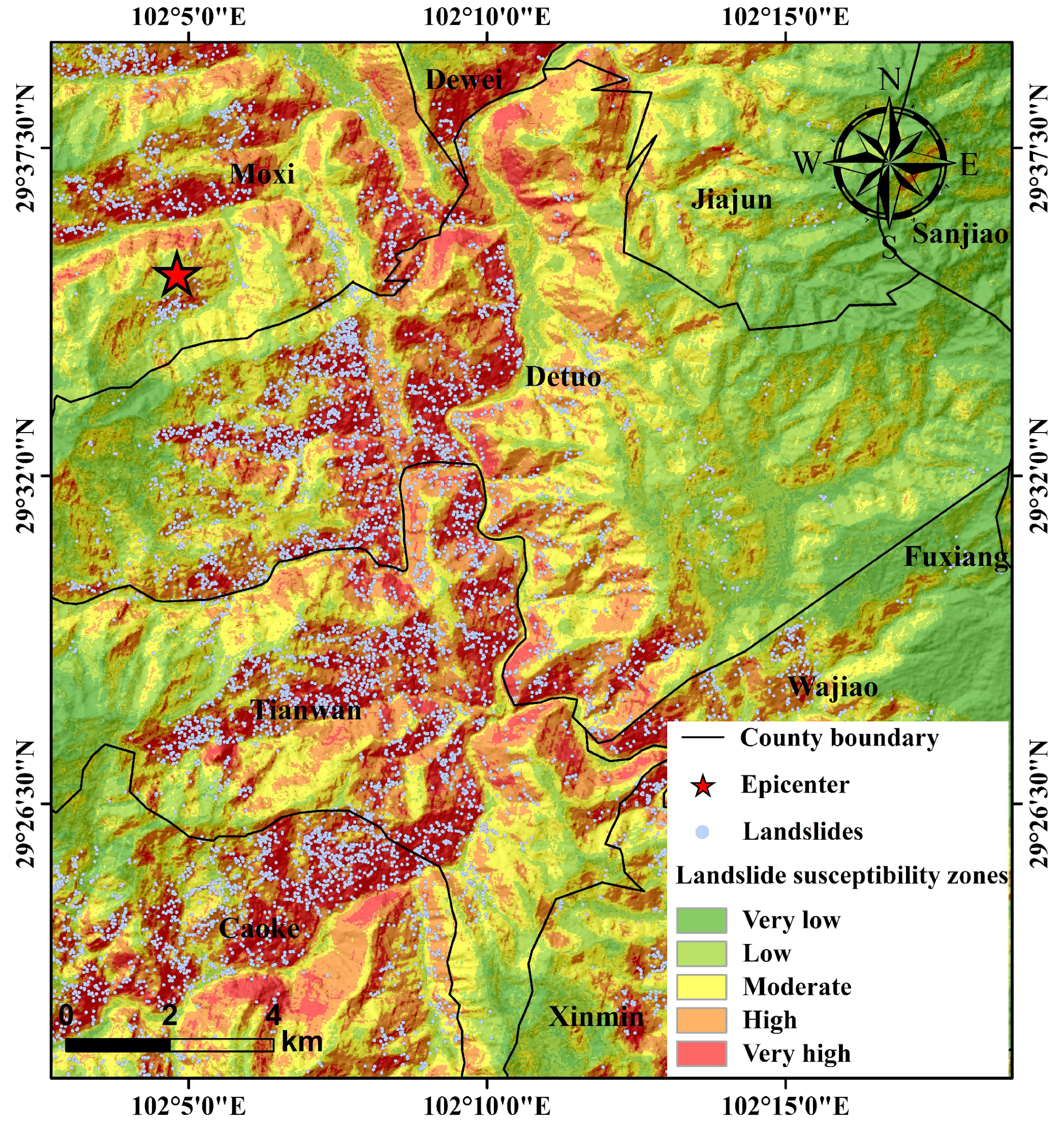
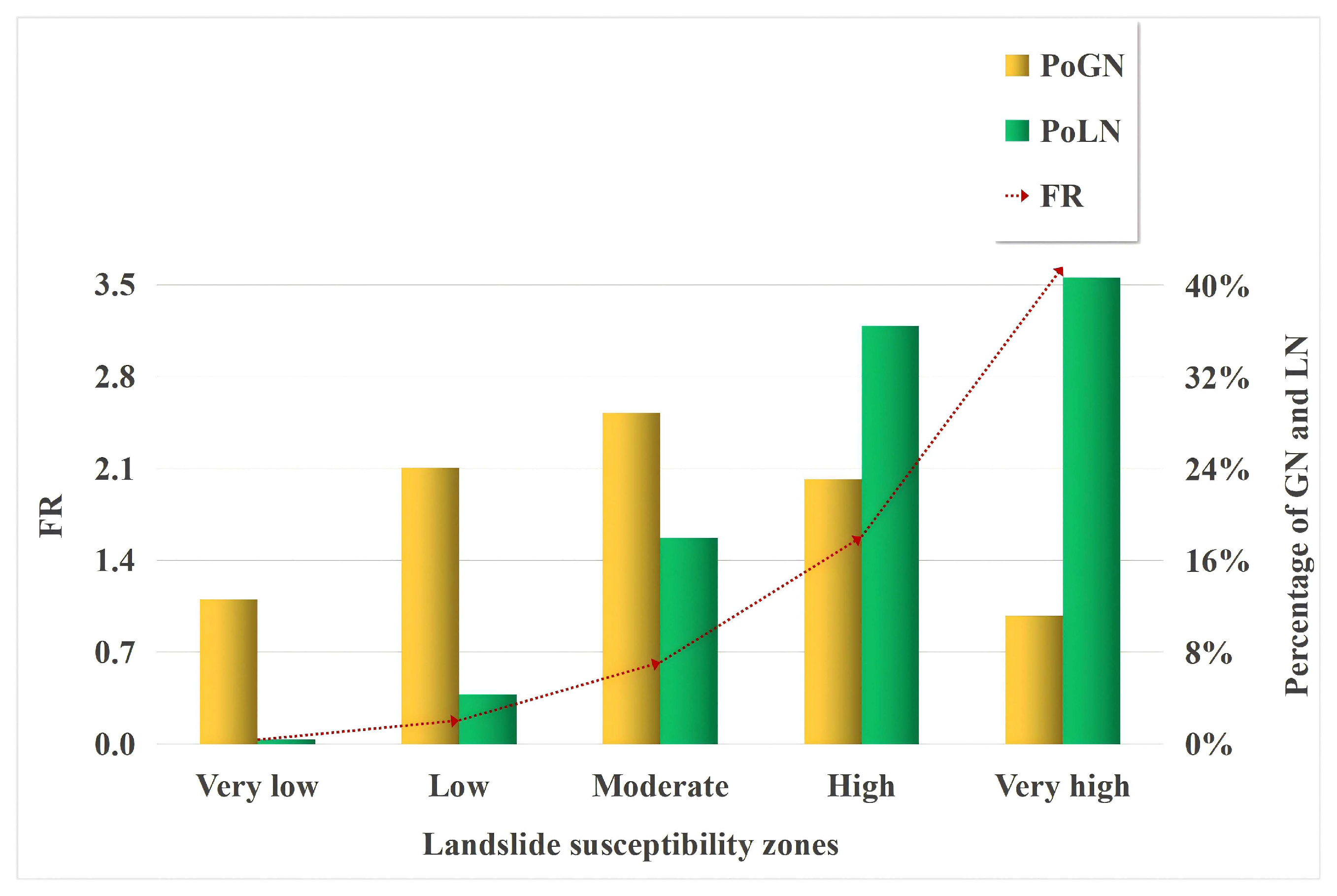
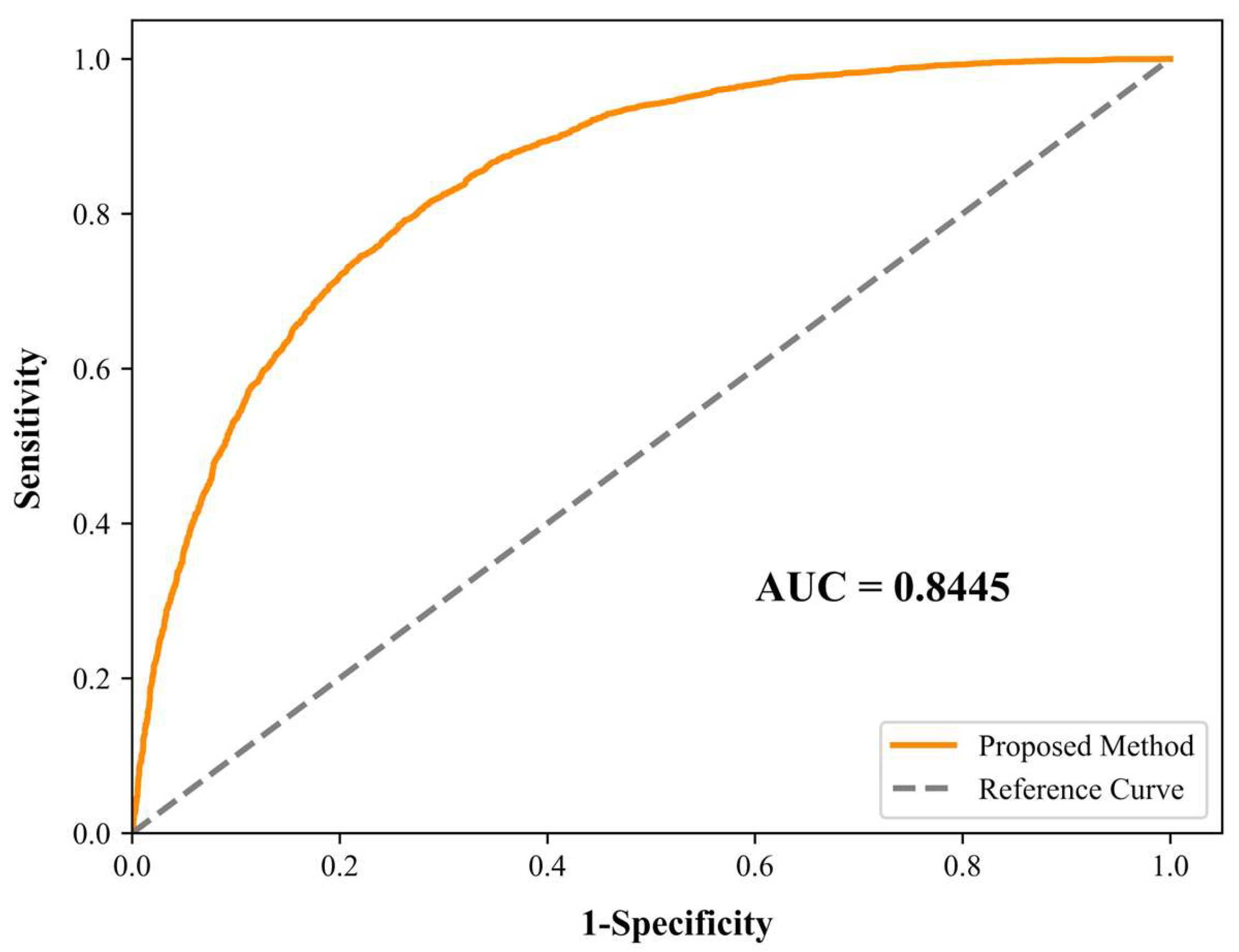
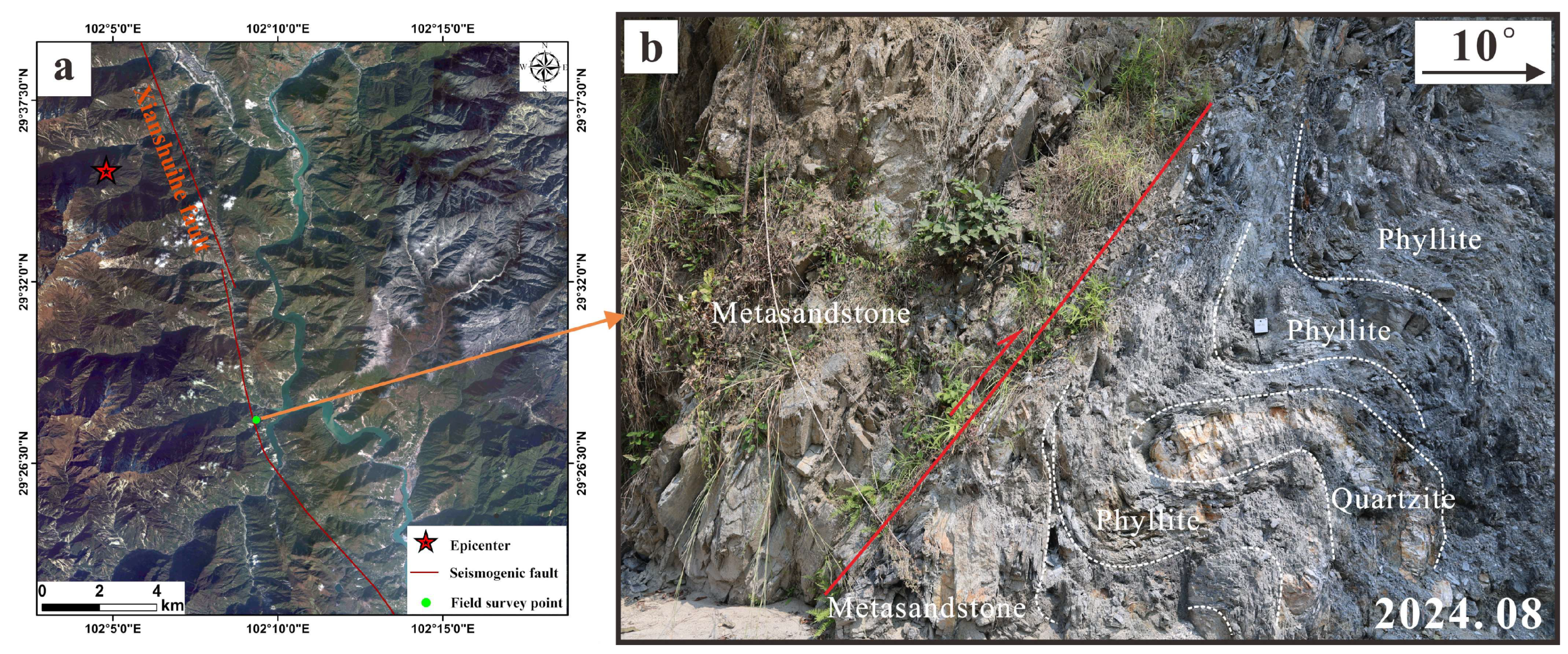
| Data | Source | Spatial Resolution |
|---|---|---|
| Coseismic landslide inventory | Data collection, remote-sensing interpretation, and field survey | -- |
| Satellite image | https://www.ovital.com, (accessed on 28 November 2022) | 1:200,000 |
| DEM | https://www.gscloud.cn/, (accessed on 28 November 2022) | 30 m |
| River network | Manual sketching | -- |
| Strata chronology | https://geocloud.cgs.gov.cn, (accessed on 28 November 2022) | 1:200,000 |
| PGA | https://data.earthquake.cn/index.html, (accessed on 21 May 2024) | -- |
| Fractional vegetation cover, (FVC) | https://www.gscloud.cn/, (accessed on 14 April 2020) | 30 m |
| Road network | https://www.usgs.gov | -- |
| n | 1 | 2 | 3 | 4 | 5 | 6 | 7 | 8 | 9 | 10 | 11 | 12 | 13 | 14 | 15 |
|---|---|---|---|---|---|---|---|---|---|---|---|---|---|---|---|
| RI | 0 | 0 | 0.52 | 0.89 | 1.12 | 1.26 | 1.36 | 1.41 | 1.46 | 1.49 | 1.52 | 1.54 | 1.56 | 1.58 | 1.59 |
| Factor | Elevation | Slope Gradient | Slope Aspect | Plan Curvature | Profile Curvature |
|---|---|---|---|---|---|
| 0.1235 | 0.1472 | 0.1476 | 0.1124 | 0.1144 | |
| Factor | Surface cutting degree | Topographic relief | Elevation coefficient variation | Lithology | Distance to faults |
| 0.1282 | 0.1394 | 0.1554 | 0.1066 | 0.1119 | |
| Factor | Epicentral distance | PGA | Distance to rivers | FVC | Distance to roads |
| 0.0664 | 0.1304 | 0.0982 | 0.116 | 0.0816 |
Disclaimer/Publisher’s Note: The statements, opinions and data contained in all publications are solely those of the individual author(s) and contributor(s) and not of MDPI and/or the editor(s). MDPI and/or the editor(s) disclaim responsibility for any injury to people or property resulting from any ideas, methods, instructions or products referred to in the content. |
© 2025 by the authors. Licensee MDPI, Basel, Switzerland. This article is an open access article distributed under the terms and conditions of the Creative Commons Attribution (CC BY) license (https://creativecommons.org/licenses/by/4.0/).
Share and Cite
Wang, J.; Zang, M.; Peng, J.; Xu, C.; Su, Z.; Liu, T.; Li, M. Identification of Dominant Controlling Factors and Susceptibility Assessment of Coseismic Landslides Triggered by the 2022 Luding Earthquake. Remote Sens. 2025, 17, 2797. https://doi.org/10.3390/rs17162797
Wang J, Zang M, Peng J, Xu C, Su Z, Liu T, Li M. Identification of Dominant Controlling Factors and Susceptibility Assessment of Coseismic Landslides Triggered by the 2022 Luding Earthquake. Remote Sensing. 2025; 17(16):2797. https://doi.org/10.3390/rs17162797
Chicago/Turabian StyleWang, Jin, Mingdong Zang, Jianbing Peng, Chong Xu, Zhandong Su, Tianhao Liu, and Menghao Li. 2025. "Identification of Dominant Controlling Factors and Susceptibility Assessment of Coseismic Landslides Triggered by the 2022 Luding Earthquake" Remote Sensing 17, no. 16: 2797. https://doi.org/10.3390/rs17162797
APA StyleWang, J., Zang, M., Peng, J., Xu, C., Su, Z., Liu, T., & Li, M. (2025). Identification of Dominant Controlling Factors and Susceptibility Assessment of Coseismic Landslides Triggered by the 2022 Luding Earthquake. Remote Sensing, 17(16), 2797. https://doi.org/10.3390/rs17162797










